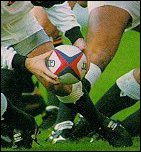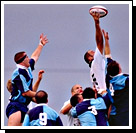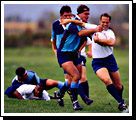














![]()
'97 Review
Cowes
Cricket in the W.Indies
FA Cup
Five Nations
Formula One
Horse of the Year
Tour de France
Wimbledon
Winter Olympics
World Match Play
World Series Athletics
World Snooker C'ship


The Five Nations Championship

 Results 1998 ]
Results 1998 ][
 Countries ] [
Countries ] [  History ] [
History ] [  Fixtures 1998 ]
Fixtures 1998 ][
 Grounds ] [
Grounds ] [  Cups ] [
Cups ] [  Home ]
Home ]
February 7 1998
France 24 England 17
Ireland 16 Scotland 17
February 21
England 60 Wales 26
Scotland 16 France 51
March 7
France 18 Ireland 16
Wales 19 Scotland 13
March 21
Ireland v Wales, Landsdowne Road, Dublin
March 22
Scotland v England, Murrayfield, Edinburgh
April 4
England v Ireland, Twickenham, London
April 5
Wales v France, Wembley

 The Five Nations
The Five Nations
The Five Nations Rugby Championships take place each year between the countries of the home nations and France. Italy is due to join the tournament in the year 2000, to make it a six-nation event.
 The Championships are held at five famous rugby grounds. All the nations competing hope to win the tournament outright with a Grand Slam but for rugby fans there is much more at stake. Each home country competes for the Triple Crown while England and Scotland also play for the historic Calcutta Cup. These tournaments within a tournament add a special interest to the games.
The Championships are held at five famous rugby grounds. All the nations competing hope to win the tournament outright with a Grand Slam but for rugby fans there is much more at stake. Each home country competes for the Triple Crown while England and Scotland also play for the historic Calcutta Cup. These tournaments within a tournament add a special interest to the games.
- England
- Scotland
- Ireland
- Wales
- France
 The championship is one of the oldest sporting contest in the world of rugby. It was first contested in 1884 between England, Wales, Scotland and Ireland. France made it a Five Nations Tournament when it joined in 1910. It has taken place almost every year since that date with a few exceptions.
The championship is one of the oldest sporting contest in the world of rugby. It was first contested in 1884 between England, Wales, Scotland and Ireland. France made it a Five Nations Tournament when it joined in 1910. It has taken place almost every year since that date with a few exceptions.
The longest interruption was from 1931 to 1946. The home countries of England, Wales, Scotland and Ireland continued to contest the event but France was banned from the championships due to differences between itself and the home countries. These differences were resolved in 1939 but then the tournament was postponed until after the end of World War II in 1946. Since that time only the championships of 1972 have been disrupted for political reasons.

 Tournaments within a Tournament
Tournaments within a Tournament
There are four prizes to be won during the tournament:
- The Five Nations Champions Title
- The Calcutta Cup
- The Triple Crown
- The Grand Slam
This can be won outright by the team with the most points at the end of the championships. Two points are awarded for a win and one for a draw. A full list of results since 1910 is given in the table below.
The Calcutta Cup
Scotland and England have played each other annually since 1871. It is the longest running match series in the world. When the Calcutta Football Club in India ceased to exist in 1877, the committee changed their remaining funds into silver rupees. These were melted down and made into the Calcutta Cup by Indian craftsmen. The cup was presented to the Rugby Union in England and since 1879, the trophy has been awarded to the winning side in the match between England and Scotland.
Results since 1871
| Played 114 | England 58 wins | Scotland 39 wins | 17 drawn games |
The Triple Crown
The Triple Crown is contested between the home countries, England, Wales, Ireland and Scotland. The team to achieve the Triple Crown title is the one who beats the other three home countries in one season's championships.
The Grand Slam
This title is awarded to the team that beats all the other four countries during one season's championship.
Five Nations Facts and Figures (Since 1910)
| Country | 5 Nation Outright Winners | Triple Crown Winners | Grand Slam Winners |
| England | 17 | 17 | 11 |
| Scotland | 6 | 5 | 3 |
| Wales | 15 | 11 | 6 |
| Ireland | 7 | 4 | 1 |
| France | 10 | - | 5 |
Twickenham
- Date Built: 1907
- Capacity: 77,000
- First International Match: England v Wales 1910
Administration Centre
Rugby Football Union
Twickenham
Middlesex, TW1 1DZ
Cardiff Arms Park/ Millenium Stadium

- Arms Park - Date Built: Started 1968 (finished 1980)
Millenium Stadium - Date Built: 1997- 9 - Arms Park - Capacity: 52,554
Millenium Stadium - Capacity: 75,000
The Millenium Stadium is designed for all-year, all-weather use. It will be the first in the UK with a retractable roof - the first of its type in the world.
Administration Centre
Welsh Rugby Union
PO Box 22
Cardiff
CF1 1JL
Murrayfield

- Date Built: 1925
- Capacity: 60,000
- First International Match: Scotland v England 1925
Administration Centre
Scottish Rugby Union
Murrayfield
Edinburgh
Landsdowne Road

- Date Built: 1878
- Capacity: 55,000
Administration Centre
Irish Rugby Football Union
62 Landsdowne Road
Ballsbridge
Dublin
Stade de France

- Date Built: 1997
- Capacity: 80,000
The new national stadium Stade de France, opened on 28 January 1998, is now the home venue for the 5 Nations. It is a modern, all seater stadium, 1.5km from Paris, that will hosts many international events. The lower stand, with its capacity of 25 000, is moveable. It can slide 15 metres back under the middle stand revealing the entire athletics track and the jumping areas. This feature is a world first and means that the Stade de France can be converted into a 75, 000 seat Olympic stadium, although the crowd at football and rugby matches will still be able to be as close as possible to the pitch.
Whenever the French play one of their matches, at any venue, someone always manages to sneak a cockerel into the ground although it is illegal. They let the animal onto the pitch during the game in the hope that it will bring them luck.
Stade de France
http://194.2.229.4/sdf/ang/index.htm
 Results 1998 ]
Results 1998 ][
 Countries ] [
Countries ] [  History ] [
History ] [  Fixtures 1998 ]
Fixtures 1998 ][
 Grounds ] [
Grounds ] [  Cups ] [
Cups ] [  Home ]
Home ]




